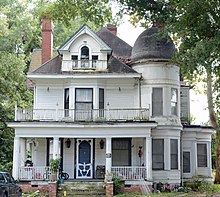Barber & Kluttz
Appearance

Barber & Kluttz, spelled often as Barber & Klutz, was an architectural firm of Knoxville, Tennessee that produced pattern books used across the United States. It was a partnership of George Franklin Barber (1854 – 1915) of Tennessee and Thomas A. Kluttz of Georgia.[1]

A number of works using its designs are listed on the U.S. National Register of Historic Places.[2]
Works include:
- George Ferris Mansion, 607 W. Maple St., Rawlins, Wyoming (Barber & Kluttz), NRHP-listed[2]
- James L. Fleming House, 302 S. Greene St., Greenville, North Carolina (Barber & Kluttz), NRHP-listed[2]
- Orth C. Galloway House, 504 Park St., Clarendon, Arkansas (Barber & Kluttz), NRHP-listed[2]
- Dred and Ellen Yelverton House, 1979 NC 222 E., Fremont, North Carolina (Barber & Kluttz), NRHP-listed[2]
- Annamede, RD 1, Box 126, US 19, Walkersville, West Virginia (Barber & Kluttz), NRHP-listed[2]
- Robert L. Covington House, 240 S. Extension St., Hazlehurst, Mississippi (Barber & Kluttz), NRHP-listed[2]
- Fairchild House, 302 S. Main St., Monticello, Kentucky (Barber & Kluttz), NRHP-listed[2]
- First National Bank of Greenville, Main and S. Poplar Sts., Greenville, Mississippi (Barber & Kluttz), NRHP-listed[2]
- Lonnie A. Pope House, Jackson St. and Central of Georgia RR tracks, Douglas, Georgia (Barber & Kluttz), NRHP-listed[2]
- Dr. R.P. Anderson House (1903), 665 N. Main St., in North Main Street Historic District of Mocksville, North Carolina (Barber & Kluttz), NRHP-listed[2][3]
See also
[edit]- List of George Franklin Barber works, which includes some of these and other Barber works not involving partnership with Kluttz, without distinction
References
[edit]- ^ M. Ruth Little (2009). "North Carolina Architects & Builders: Barber, George F. (1854-1915)".
- ^ a b c d e f g h i j k "National Register Information System". National Register of Historic Places. National Park Service. July 9, 2010.
- ^ David R. Black (1990). North Main Street Historic District (PDF). National Register of Historic Places Registration. North Carolina State Historic Preservation Office. Retrieved 2022-12-28.
